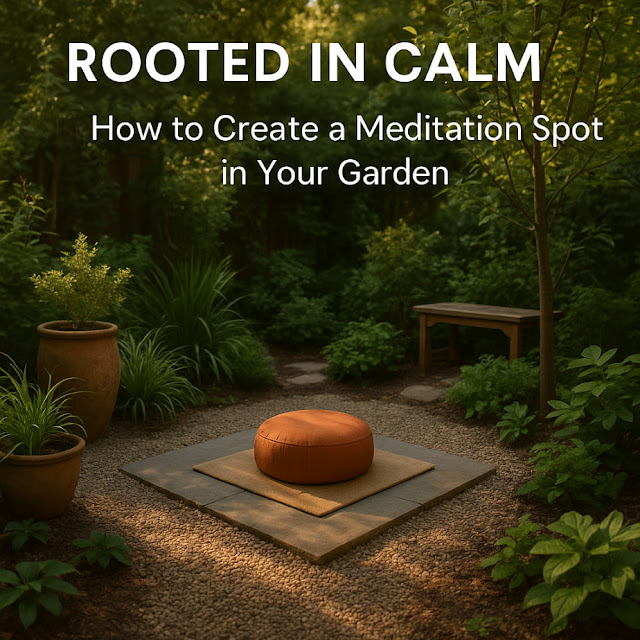In a world that rarely slows down, the quest for inner peace is more important than ever. Meditation offers that stillness—helping to reduce stress, enhance focus, and connect us with ourselves. But where we choose to meditate is just as essential as the practice itself. Imagine a dedicated space surrounded by birdsong, rustling leaves, and soft natural light—a personal sanctuary right in your own backyard. That's the power of setting up a meditation spot in your garden. Contrary to popular belief, you don’t need sprawling acreage or elaborate landscaping. You can create a garden meditation spot that suits your rhythm and space, whether it's a chilly garden grove, a sunny balcony, or a secret nook under a tree.
How to Create a Meditation Spot in Your Garden
1. Recognize the Cause: Nature's Healing Potential
Spending time in green spaces isn’t just relaxing—it’s restorative. According to a 2019 study published in Nature Scientific Reports, spending at least 120 minutes per week in nature significantly boosts mental well-being and physical health. Combining this with meditation multiplies the benefits.
Nature provides a multisensory experience that enhances mindfulness. The sound of rustling leaves, the warmth of the sun, and the aroma of the earth all help to soothe the mind. In fact, research from the University of Exeter found that outdoor meditation increased relaxation and reduced cortisol levels more effectively than indoor settings.
2. Choose the Right Location
Choose a peaceful, semi-private area of your garden to start, away from busy streets or foot traffic.
Here are a few ideas:
- Under a canopy or tree grove where filtered light and birdsong soothe your senses.
- Near water features like fountains or ponds—moving water adds a calming soundtrack.
- Tucked in hedges or tall grasses for a cocoon-like feel.
- Next to fragrant plants like jasmine, rosemary, or lavender, which promote relaxation.
Pro tip: Test different spots at various times of the day to gauge sunlight, shade, and temperature.
Morning light is gentle and energizing—ideal for AM sessions.
Read More: Stylish Low-Maintenance Gardens for Busy Lifestyles
3. Design for Simplicity & Stillness
Keep your meditation spot clutter-free. This isn’t a place for garden tools or décor overload—it’s about intentional calm.
Base elements to consider:
- Grounding surface: A flat deck, stone slab, or yoga mat over gravel or grass provides stability.
- Comfort: Use a meditation cushion, wooden bench, or weather-resistant chair. Consider a low platform to elevate the experience.
- Shade & Shelter: A pergola draped in vines or a canopy tent can offer protection from sun or rain while maintaining an open-air feel.
For a natural boundary, incorporate bamboo screens, tall planters, or trellises with climbing plants to subtly separate the space from the rest of the garden.
4. Choose Mindful Plantings
Plants can deepen your sensory connection during meditation. Choose species that appeal to the senses without requiring a lot of upkeep.
Best choices:
- Lavender & chamomile for calming fragrance.
- Ornamental grasses or bamboo for a gentle rustle in the wind.
- Succulents or mosses for touch and visual texture.
- Native flowering plants to attract butterflies and hummingbirds—nature’s quiet companions.
A garden grove of low-maintenance trees such as olive, birch, or Japanese maple can provide shelter and symbolic grounding.
5. Add Subtle Enhancements
Simple additions can elevate your garden meditation zone without cluttering it:
- Sound: A wind chime or soft water feature.
- Sight: A sculptural rock, Buddha statue, or natural focal point to anchor your gaze.
- Lighting: Solar lanterns or string lights for early mornings or dusk meditations.
- Aromatherapy: Planting fragrant herbs or using essential oil diffusers with earthy tones like sandalwood or cedarwood.
6. Case Study: A Minimalist Garden Grove in Surrey
Landscape designer Joanna Craven transformed a narrow backyard in Surrey into a contemplative garden grove using birch trees, gravel pathways, and a single teak bench tucked behind tall ornamental grasses. Her client, a corporate executive, uses it daily for sunrise meditation. “He says, "It's like entering a different world.". The grove offers unending tranquility with only one hour of maintenance per month.
7. Maintain Without the Stress
You shouldn't add your meditation area to your list of things to do. Here’s how to keep it effortless:
Use native, drought-tolerant plants to reduce watering.
Mulch heavily to suppress weeds and retain moisture.
Install drip irrigation for consistent, low-effort watering.
Sweep or rake once weekly—a meditative act in itself.
Let the space evolve with the seasons. Fall leaves? Let them linger. Spring blooms? Welcome them in. It’s about observing, not controlling.
Conclusion
Creating a meditation spot in your garden isn’t just about design—it’s about intention. It’s a space that honors stillness, supports your mental well-being, and deepens your connection to the natural world. Backed by science, supported by mindful planning, and rooted in personal experience, a garden grove meditation nook is a sanctuary that grows with you.
So pause. Breathe. Step outside. Your garden isn’t just a place for plants—it’s a space for peace.







